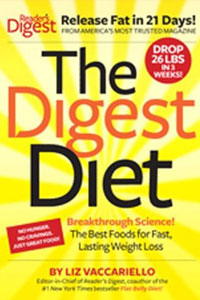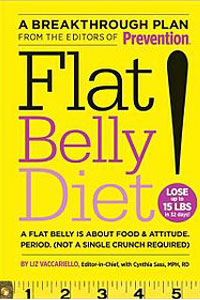If you’re looking for a new book to help you in your weight loss journey, we may have a new suggestion for you – or two.
Much buzz is surrounding the recent release of the diet book “The Digest Diet,” which is written by Reader’s Digest Editor-in-Chief, Liz Vaccariello. You may recognize Vaccariello’s name from two of her other successful projects,the “Flat Belly Diet” and “400 Calorie Fix” – two books she co-authored while working for Prevention Magazine.
Because “The Digest Diet” (2025) and “Flat Belly Diet” (2025) can seem similar at first glance, we’ve done a side-by-side comparison of the two to set the likenesses and differences straight.
While both books claim to help dieters lose weight, they utilize different approaches and keep different principles in mind. We’ve broken the comparisons up into categories starting with their respective claims.
Claims – “The Digest Diet” claims participants will lose up to 26 pounds in three weeks by following the diet set forth in the 21-day menu. The menu includes recipes for each meal of the day and clearly outlines what foods and snacks are and aren’t allowed on the diet. The “Flat Belly Diet” claims to provide the secret to getting a flat tummy, with 91 percent of their participants seeing a noticeable loss in belly fat.
Focus – “The Digest Diet” focuses on five healthy meals per day with hearty snacks to help dieters stay full. It also includes 22 lifestyle changes to help curb cravings and aid weight loss. The focus of the “Flat Belly Diet” is on a diet rich in monounsaturated fats to target belly fat reduction while promoting weight loss. Preferred foods include olive oil, nuts, seeds, olives and even chocolate.
Meals – Two examples of the meals available in “The Digest Diet” are an Italian soup with shrimp and zucchini, and a chili-rubbed pork. A typical meal for the “Flat Belly Diet” is a 4-ounce grilled tilapia filet, one cup of steamed green beans, and a half cup of roasted red potatoes drizzled with olive oil. The focus of the latter is more on heart-healthy fats.
 Water – While both books focus on drinking plenty of water, the “Flat Belly Diet” promotes a special water that includes ginger to aid in digestion – which was deemed “sassy water” after one of its authors, Cynthia Sass, RD.
Water – While both books focus on drinking plenty of water, the “Flat Belly Diet” promotes a special water that includes ginger to aid in digestion – which was deemed “sassy water” after one of its authors, Cynthia Sass, RD.
Exercise – One of the major differences in these books lies in exercise. The “Flat Belly Diet” downplays the need to exercise and doesn’t involve any workout recommendations. “The Digest Diet,” on the other hand, recommends exercise as part of the program, suggesting weight training and high intensity interval training (HIIT). It even includes a 12-minute exercise routine to instruct users on exactly what types of activity they should be doing to achieve maximum results.
Support – Both of the diets include a support system of some kind. The “Flat Belly Diet” encourages joining an online support system, and “The Digest Diet” has an official Facebook fan page where dieters can join the page, share their progress, and track their friends’ victories and setbacks as well.
Cost – The “Flat Belly Diet” costs approximately $17, while the “The Digest Diet” will set you back closer to $32 plus tax and delivery.
Pointing out the differences and similarities in these popular diet books gave us a better understanding of what the two hope to achieve when it comes to health and weight loss. Overall, “The Digest Diet” seems to focus more on exercise, weight loss and a healthy lifestyle; and the “Flat Belly Diet” focuses more on targeting belly fat and getting heart-healthy.
Also Read:
Flat Belly Diet Before and After [VIDEO]
